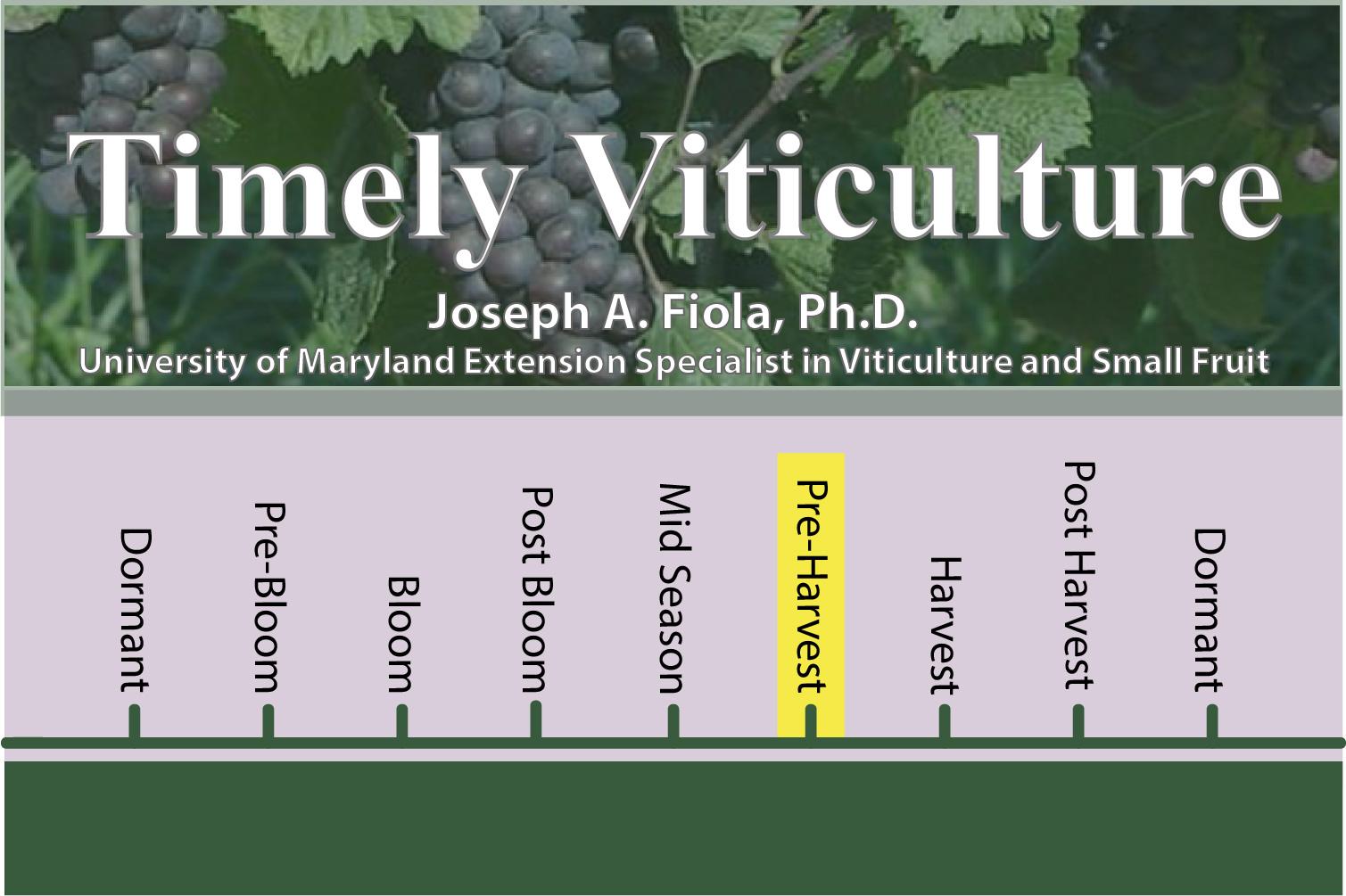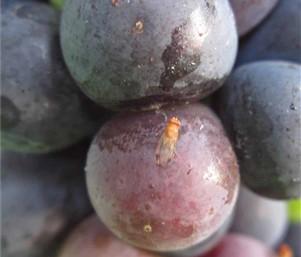Control
There are some important cultural controls that growers can adopt to minimize the buildup of populations.
- The highest risk varieties are those that are harvested later and varieties with thinner skins.
- Remove damaged, overripe, or rotten fruit when present
Chemical control measures are directed against the adults; there are no effective controls for larvae in the fruit.
- If significant economic damage is being observed, weekly spray applications may be needed. A few damaged grapes do not warrant a field spray!
- When using organic materials, shorter spray intervals will be needed because of the shorter residual life of botanical insecticides.
- As always, insecticides* with a different mode of action should be rotated in order to delay the development of insecticide resistance. The selection of insecticides for SWD control should take into account other pests present, harvest date, re-entry restrictions, as well as the potential impacts on existing IPM programs, beneficial insects, and the environment.
- The following are effective:
- Carbamates (IRAC Class 1A= carbaryl, Sevin)
- Organophosphates (IRAC Class 1B = malathion; phosmet; Imidan)
- Pyrethroids (IRAC Class 3 = Brigade; Baythroid; Danitol; Mustang Max; Tombstone; (be wary of induction of secondary pests))
- Spinosyns (IRAC Class 5 = Delegate; Radiant)
- For details please see Virginia Tech Pest Management: http://pubs.ext.vt.edu/456/456-017/Section-3_Grapes-1.pdf
- Organic (OMRI approved) options:
- Pyrethrins (IRAC Class 3 = PyGanic (be wary of induction of secondary pests))
- Spinosyns (IRAC Class 5 = Entrust)
- Grandevo 30 (Chromobacterium IRAC Class unknown)
- Surround 95WP3 (kaolin; IRAC Class unknown) has shown efficacy, especially on red grapes, and may be a good choice as a first response or in a low-pressure situation. Surround may impact harvest parameters.
*Remember to follow the label restrictions and rotate chemical classes to avoid resistance development. If this pest is present, the level of control will depend on the size of the SWD population, timeliness of application, coverage of fruit, and product effectiveness.

 English
English العربية
العربية Български
Български 简体中文
简体中文 繁體中文
繁體中文 Hrvatski
Hrvatski Čeština
Čeština Dansk
Dansk Nederlands
Nederlands Suomi
Suomi Français
Français Deutsch
Deutsch Ελληνικά
Ελληνικά हिन्दी
हिन्दी Italiano
Italiano 日本語
日本語 한국어
한국어 Norsk bokmål
Norsk bokmål Polski
Polski Português
Português Română
Română Русский
Русский Español
Español Svenska
Svenska Català
Català Filipino
Filipino עִבְרִית
עִבְרִית Bahasa Indonesia
Bahasa Indonesia Latviešu valoda
Latviešu valoda Lietuvių kalba
Lietuvių kalba Српски језик
Српски језик Slovenčina
Slovenčina Slovenščina
Slovenščina Українська
Українська Tiếng Việt
Tiếng Việt Shqip
Shqip Eesti
Eesti Galego
Galego Magyar
Magyar Maltese
Maltese ไทย
ไทย Türkçe
Türkçe فارسی
فارسی Afrikaans
Afrikaans Bahasa Melayu
Bahasa Melayu Kiswahili
Kiswahili Gaeilge
Gaeilge Cymraeg
Cymraeg Беларуская мова
Беларуская мова Íslenska
Íslenska Македонски јазик
Македонски јазик יידיש
יידיש Հայերեն
Հայերեն Azərbaycan dili
Azərbaycan dili Euskara
Euskara ქართული
ქართული Kreyol ayisyen
Kreyol ayisyen اردو
اردو বাংলা
বাংলা Bosanski
Bosanski Cebuano
Cebuano Esperanto
Esperanto ગુજરાતી
ગુજરાતી Harshen Hausa
Harshen Hausa Hmong
Hmong Igbo
Igbo Basa Jawa
Basa Jawa ಕನ್ನಡ
ಕನ್ನಡ ភាសាខ្មែរ
ភាសាខ្មែរ ພາສາລາວ
ພາສາລາວ Latin
Latin Te Reo Māori
Te Reo Māori मराठी
मराठी Монгол
Монгол नेपाली
नेपाली ਪੰਜਾਬੀ
ਪੰਜਾਬੀ Afsoomaali
Afsoomaali தமிழ்
தமிழ் తెలుగు
తెలుగు Yorùbá
Yorùbá Zulu
Zulu ဗမာစာ
ဗမာစာ Chichewa
Chichewa Қазақ тілі
Қазақ тілі Malagasy
Malagasy മലയാളം
മലയാളം සිංහල
සිංහල Sesotho
Sesotho Basa Sunda
Basa Sunda Тоҷикӣ
Тоҷикӣ O‘zbekcha
O‘zbekcha አማርኛ
አማርኛ Corsu
Corsu Ōlelo Hawaiʻi
Ōlelo Hawaiʻi كوردی
كوردی Кыргызча
Кыргызча Lëtzebuergesch
Lëtzebuergesch پښتو
پښتو Samoan
Samoan Gàidhlig
Gàidhlig Shona
Shona سنڌي
سنڌي Frysk
Frysk isiXhosa
isiXhosa
